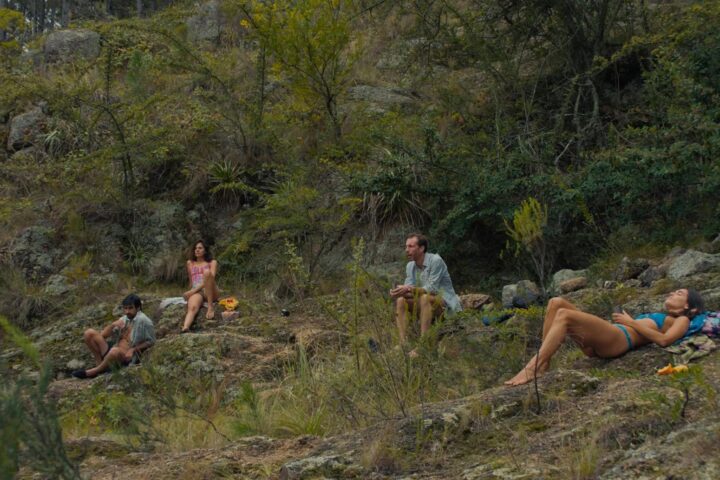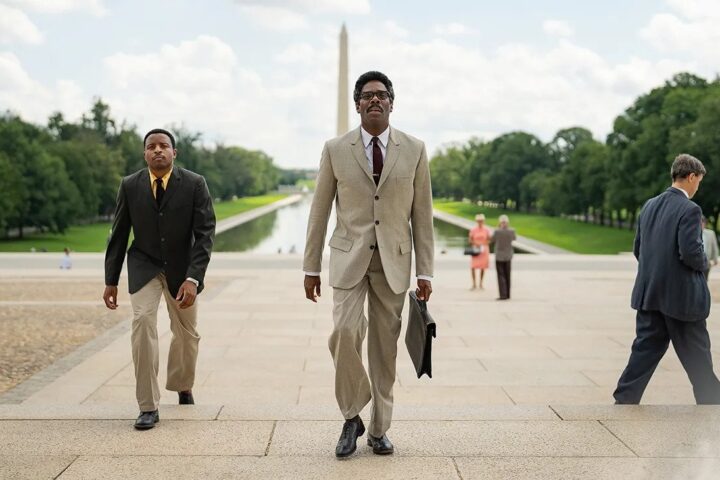Rodrigo Moreno’s heist thriller The Delinquents has many tricks up its sleeve, from outsized musical motifs to droll office comedy. Yet one of the most potent tools at Moreno’s disposal is one that was unplanned. Like the events chronicled in the film, the production spread out across over five years, a duration that created a space for the Argentine writer-director to contemplate deep existential questions as if in parallel with his characters. It’s but one pane in a full house of mirrors that creates some fascinating cinematic refractions.
Though the robbery of a Buenos Aires bank marks the inciting incident of The Delinquents, this sui generis crime caper quickly moves beyond tactical considerations and enters a philosophical realm for Morán (Daniel Elías) and Román (Esteban Bigliardi). The former of the two bank employees smuggles out enough money for both men to retire, wagering that a few years spent in prison is a price worth paying to avoid decades of additional work.
Morán entrusts Román with keeping the plan in motion until his sentence is over, requiring him to both stay the course in their workplace and stash the cash outside the city in Córdoba. Across their winding journey, the pursuit of an elusive freedom brings both men into contact with countless doubles and paradoxes. Moreno wisely leaves these contradictions unresolved to the end. By letting the tensions linger, the film highlights the impossibility and absurdity of trying to liberate oneself using tools from the capitalistic system that prompted such a need for escape.
I spoke with Moreno ahead of The Delinquents’s U.S. premiere at the New York Film Festival. Our conversation covered his cinematic influences, the pandemic’s effect on the film’s point of view, and his interest in playful puzzles like anagrams.
You name-check directors who influenced you in the press notes, but one name that’s missing is one we see in the film: Jean-Luc Godard. Was it a coincidence that his last feature was playing at the theater when you were shooting? His approach to exploding genres seems in line with your aims in The Delinquents.
When we were shooting that scene in front of a cinema that I used to go when I was a teenager, there were signs for Roma, Alfonso Cuarón’s film that I really didn’t like. I asked them, “What other posters do you have?” The guy who was working there didn’t know anything about movies, and he said, “Well, take a look.” I found many posters of The Image Book, so that’s why Godard is there. Godard isn’t [specifically] an influence because when you think of influences, you think in terms of gestures and style. Godard is an influence on the 20th century [at large]. He’s more than a filmmaker. He’s a philosopher who obliges you to think of many other things than just film language. Everyone who makes films after modernism is influenced by Godard.
Were there other films or stylistic influences that shaped the way that you thought about genre from that era?
The origin of this film is an old movie from the 1940s, Hugo Fregonese’s Hardly a Criminal. [My film] isn’t a remake. I transform [the original material] and lead it to a different place. [It allowed] me to play with film language. If I have to think about a constellation of filmmakers that I thought of while shooting this film, I would say Melville and Chabrol. They reinterpreted the American noir, and I like that. There are also these traditions in the second part of the movie that are probably [inspired by the] French, from [Jean] Renoir and Jacques Rozier, a good filmmaker from the Nouvelle Vague who’s not as well-known.
The inspiration from Hardly a Criminal lends the film an aura of timelessness, but was there also something more contemporary behind your inspiration? Something about preferring three-and-a-half years in prison to 20 years of working feels very of the moment.
This timeless spirit has to do more with aesthetics. The film really talks to [where we are today]. We started shooting before the pandemic, and we ended after. I think the pandemic really made us rethink everything. We were rethinking our quality of life, our work, the quality of our time. But that lasted very little, because after the pandemic, the world is worse. There’s a lot of hate and resentment. There’s a lot of fights and wars. We have war happening right now in Israel and Ukraine. Popular politicians promote hate like Milei in Argentina, Trump, or Bolsonaro. The film is really in dialogue with the current world, and this is where the film becomes contemporary. We’re talking about a world that’s very complicated.
Did that observation change at all the way that you shot the bank sections of the film, which were among the last to be shot?
Sometimes, you find out what you shot after shooting. I think part of the advantage of shooting for several years is that I was discovering the movie constantly. Your observation is really good because if I had shot the bank scenes in 2018, it would be a different film. I shot those scenes with a deeper knowledge of what I was doing.
Did understanding how these scenes would fit in the edit between what you’d already shot affect the humor and tone of that section?
I was finding my movie and the tone at the same time. It’s funny, I was always thinking of the movie in different times and stages. My script was very long, and I always thought of a different stage for the bank and for the nature part. I thought I wasn’t ready to do it all at once, and I always thought I would shoot the Córdoba parts around freedom at the end. It happened just the opposite. If you want to make God laugh, you just tell him your plans. Because of that, it became richer, actually. All that helped me, and I had to be ready for that dry humor that the film has.
Was an element of duality always inherent to the story?
No, in [Hardly a Criminal], there’s only Morán, not Román. The original Morán is a greedy man, someone who wants money and doesn’t care about his brother, his mother who’s really ill, or his girlfriend. That mirrored way of building up this story is something that I discovered during my own writing. That idea of duplicity, replication, and doppelgangers happens first with one character, and the same things happen with the other character.
What interests you about the mirrors and the doubles?
The idea of two characters reaching the same destiny was something I really liked telling. How they can take strongly different journeys and finally reach more or less the same place. Morán immediately realized in the beginning about the fact of work and the use of time, but Román reaches this conclusion after many years. It’s a delayed outcome. Somehow, it’s like anagrams, which is something I realized at the end. An anagram is the same letters organized in different order with different meanings. You have two guys making similar things, taking similar decisions, reaching to the same destiny, but organized in a different order.
Does the film that Román makes out in Córdoba also fold into that theme? A reordering of reality through fiction?
No, because that film is not productive. I wanted to create a contrast between the productive world [of Buenos Aires] where they’re dedicated to work. More than that, they’re always counting and dealing with money. The opposite would be nature and people doing things that aren’t productive at all. [Román] doesn’t know what that film is about! They’re shooting a flower that blows in the wind. He doesn’t really know what he’s making, and I loved that.
In the previous version of the story, the dream was just to get rich. Now, is it just to be comfortable and exist outside of the demands for productivity?
They’re two different worlds. In the 1940s after the war, there was hope. We don’t have hope today. This is what Morán finds out. He wants a better life that’s [disconnected from the] modern world. The work, the job, the organized life—that’s what Morán rebels against.
It’s an unspoken desire among the characters, but since they never answer, I’ll ask you: What is freedom? Is it ever really achievable?
It’s an interesting question. In today’s world, there’s a homogenization of human behaviors through our businesses, our phones, and social media. We’re all under surveillance, and we just accept that the world is like that. I believe any rebellion against that is a gesture of freedom.
Is the film your gesture of freedom?
Absolutely it is.
Translation by Nuria Mendoza
Since 2001, we've brought you uncompromising, candid takes on the world of film, music, television, video games, theater, and more. Independently owned and operated publications like Slant have been hit hard in recent years, but we’re committed to keeping our content free and accessible—meaning no paywalls or fees.
If you like what we do, please consider subscribing to our Patreon or making a donation.





